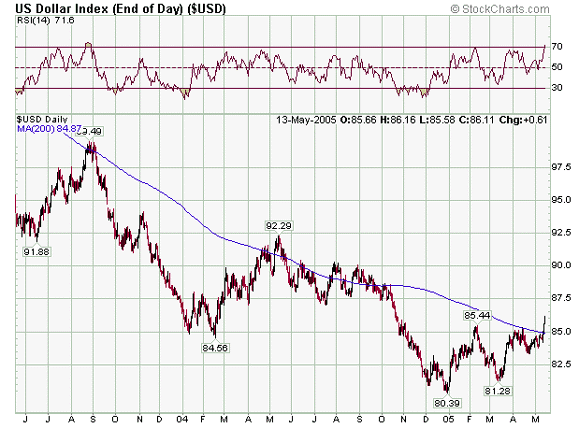|
|||
The U.S. Dollar is still the Key for Gold's Next MoveLou Passi In December 2004 we saw the beginning of another U.S. dollar correction within its overall four-year bear market decline to-date. This latest dollar correction has weakened gold and mining shares and provided "buy-on-the-dip" opportunities for both. But the correction, now approaching 6 months, has been stronger and lasted longer than I and many others anticipated. With the U.S. dollar recently breaking above its 200 day moving average and gold and the mining stock indexes breaking below their four-year support lines, doubt begins to creep in questioning whether the secular gold bull and secular dollar bear markets have ended. If you've been buying the gold dips during the past six months, as I have, it is likely those are losing positions today. Meanwhile, fear or despair may be clouding your judgement as those losses grow daily. We need to take an objective look at the U.S. dollar to understand its current strength and determine where it is headed before deciding whether to lighten, unload, simply hold (do nothing), or add to our gold and mining stock investments now. U.S. Dollar Fundamentals Why has the U.S. dollar strengthened over the past six months? I think there are three broad possible answers and any one or all of them are legitimate factors. 1. Dollar shorts have been unwinding their trades to lock in profits and, as a result, they have prolonged this current dollar rally. The rally began in December 2004 when the dollar bounced off a major, decades-low support level near 80. Had I been more cautious, I would have had the foresight to see this as the opportune time to unload or lighten more gold mining shares than I did. I won't make that mistake again. 2. Currency traders are going long the dollar based on an expectation of continued rate hikes in the U.S., near-term weakness in the Euro ahead of the EU constitution vote later this month, and perhaps in response to favorable government reports indicating a stronger U.S. economy. Recent reports indicate better than expected job growth and retail sales, coupled with a lower than expected budget deficit and narrowing trade gap, all of which have been reinforced by supporting comments from various Fed governors. 3. In anticipation of an imminent revaluation of China's currency, which is expected to drive the U.S. dollar lower, the U.S. Treasury may be artificially supporting or managing this recent rise in the dollar. Why? To ensure that when the dollar falls, it does so from a much higher level so that it won't take out the decades-low support level of 80. So what? I can only imagine that "never-break" level is closely tied to trillions of dollar derivative contracts that are now at risk of imploding on a breach of that support. So, fundamentally speaking, where is the U.S. dollar headed next? My guess is a reversal lower as early as next week to eventually retest the 80 support level. Why lower now? Because the market constantly looks forward and this is what it sees. 1. A flattening yield curve will force the Fed to stop or slow its rate hikes. The market knows this will be dollar negative. Long bond yields continue to drop, perhaps anticipating recession, deflation, and future rate cuts. 2. China will revalue its currency sooner than later. The market knows this will be dollar negative. Add to this recent comments from other major trading partners like Russia, North Korea, India, and Japan who all have expressed a desire to diversify their foreign reserves, which means they plan to hold or buy fewer U.S. dollars in the future. 3. Despite recent government reports, the concept of a stronger U.S. economy may be an illusion. The market anticipates weaker corporate earnings and is even starting to question the credibility of favorable U.S. data being reported. For example, mega-retailer Walmart reported disappointing first quarter results that contradict U.S. reports of strong retail sales. Reports of better than expected job growth significantly aided by a "plug" from the BLS birth/death business model fail to stand up to scrutiny. And Commerce Department reports of a "narrowing" trade deficit can't distract from record debt and trade imbalances again this year. U.S. Dollar Technical Perspective Let's take a look at the last three major corrections illustrating these trends, courtesy of Stockcharts.com.
2003: 2004: 2005: Based on patterns already established by subsequent downlegs in 2003 and 2004, the next move lower for the dollar would also be slower and more shallow than previous moves, perhaps spanning 10 months for a 10% decline to 77.50 or 79.07, depending from which of the two Fibonacci retracement peaks we reverse direction. The speed and depth of the next dollar downleg is certainly debatable and may not follow any pattern to date. Remember, we will again encounter the decades-low support level of 80 suggesting another bounce higher is possible. But it could also be argued that the dollar will finally break through support this time in anticipation of China's currency revaluation coupled with the Fed's stop or slowdown in rate hikes sometime during the second half of 2005. In conclusion, the data and arguments presented above tell me that the U.S. dollar is ready to reverse direction lower sometime over the next two weeks and, as a result, gold and mining shares are at or near bottom prices. This is the moment to acquire shares of strong gold producers and quality explorers with substantial reserves. At a minimum, hold tight to the shares you already own and resist temptation to sell them amid the fears and despair that accompany all major market bottoms. May 15, 2005 Disclaimer: All investors are encouraged to do their own research and due diligence. Lou Passi is
a private investor and retired pharmaceutical executive living
in Chicago. You can contact Mr. Passi via email at louispassi2004@comcast.net. |

